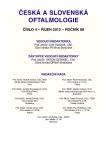Sub-internal Limiting Membrane Haemorrhage Treated by Pars Plana Vitrectomy
Authors:
V. Krásnik; J. Štefaničková; P. Strmeň; P. Kusenda
Authors‘ workplace:
Klinika Oftalmológie LF UK a UN, Bratislava, prednosta doc. MUDr. Vladimír Krásnik, PhD.
Published in:
Čes. a slov. Oftal., 68, 2012, No. 4, p. 135-139
Category:
Case Report
Overview
Purpose:
A retrospective study of anatomical and functional results of haemorrhages sub-internal limiting membrane treated by pars plana vitrectomy with internal limiting membrane peeling.
Materials and methods:
The studied group consists of 6 patients – 6 eyes with acute bleeding under internal limiting membrane at the age of 18–59 years (mean age 37,3 years). The group was ethiopathogenetically various: 1x sarcoidosis, 1x cocaine abuse, 1x alcoholic and drug-induced hepatopathy, 1x morbus von Willebrand, 1x branch retinal vein occlusion combined with macroaneuryzm, 1x unknown cause – idiopathic. Best corrected visual acuity (BCVA) was hand motion in 3 of the eyes, counting fingers at 30 cm, 20/200 or 20/63 in the other 3 eyes. After a complete ophthalmologic examination including fluorescein angiography and optical coherence tomography a 23-gauge sutureless pars plana vitrectomy with internal limiting membrane peeling was performed in all patients. The follow-up period was 3–36 months (mean follow-up 18.3 months).
Results:
In all 6 patients (6 eyes) an important improvement of visual functions was observed within 2–3 days after the surgery with a corresponding improvement of anatomical ophthalmoscopic findings and findings on optical coherence tomography. The BCVA at the last examination was 20/20 in 3 eyes, 20/32 in 2 eyes and 20/25 in 1 eye. We did not experience any complications like retinal tear, retinal detachment, endophthalmitis or relapse of bleeding neither during the surgery nor during the follow-up period.
Conclusion:
Sub-internal limiting membrane haemorrhage affect younger patients in working-age population. These patients need rapid visual recovery. Surgical treatment of sub-internal limiting membrane haemorrhages by pars plana vitrectomy with internal limiting membrane peeling is a safe and effective method, which facilitates a quick return to patients` previous working activities and social standard.
Key words:
pars plana vitrectomy, internal limiting membrane peeling, sub-internal limiting membrane haemorrhages
Sources
1. Bhatnagar, A., Wilkinson, L. B., Tyagi, A. K., Willshaw, H. E.: Subinternal Limiting Membrane Hemorrhage With Perimacular Fold in Leukemia. Arch Ophthalmol, 129; 2009 : 1548–1550.
2. De Maeyer, K., Van Ginderdeuren, R., Postelmans, L., Stalmans, P., Van Calster, J.: Sub-inner limiting membrane haemorrhages: causes and treatment with vitrectomy. Br J Ophthalmol. 91; 2007 : 869–872.
3. Friedman, S. M., Margo, C. E.: Bilateral Subinternal Limiting Membrane Hemorrhage with Terson Syndrome. Am J Ophthalmol, 124; 1997 : 850–851.
4. Gabel, V.P., Birgruber, R., Gunther-Koszka, H., Puliafito, C.A.: Nd:YAG Laser Photodisrubtion of Hemorrhagic Detachment of the Internal Limiting Membrane. Am J Ophthalmol, 107; 1989 : 33–37.
5. Gass, J.M.D.: Traumatic retinopathy. V Stereoscopic atlas of macular diseases: diagnosis and treatment. St. Louis, Mmosby, 1997 : 737–774.
6. Hesse, L., Schmidt, J., Kroll, P.: Management of acute submacular hemorrhage using recombinant tissue plasminogen activator and gas. Graefe’s Arch Clin Exp Ophthalmol, 237; 1999 : 273–277.
7. Heydenreich, A.: Treatment of preretinal haemorrhages by means of photocoagulation. Klin Monatsbl Augenheilkd, 163; 1973 : 671–676.
8. Chen, G.W., Moshfeghi, A.A.: Surgical management of massive submacular hemorrhage. Retina today, 7; 2012 : 40–44.
9. Kuhn, F., Morris, R., Witherspoon, C.D., et al.: Terson syndrome. Results of vitrectomy and the significance of vitreous hemorrhage in patients with subarachnoid hemorrhage. Ophthalmology, 105; 1998 : 472–477.
10. Kwok, A. H. K., Lai, T. Y. Y., Chan, N. R.: Epiretinal Membrane Formation with Internal Limiting Membrane Wrinkling after Nd:YAG Laser Membranotomy in Valsalva Retinopathy. Am J Ophthalmol, 136; 2003 : 763–766.
11. Mayer, C.H, Mennel, S., Rodrigues, E.B., et al.: Persistent premacular cavity after membranotomy in valsalva retinopathy evident by optical coherence tomography. Retina, 26; 2006 : 116–118.
12. Mennel, S.: Subhyaloidal and macular haemorrhage: localisation and treatment strategies. Br J Ophthalmol, 91; 2007 : 850–852.
13. Raymond, L. A.: Neodynium: YAG Laser Treatment for Hemorrhages under the Internal Limiting Membrane and Posterior Hyaloid Face in the Macula. Ophthalmology, 102; 1995 : 406–411.
14. Shukla, D., Naresh, K. B., Kim, R.: Optical Coherence Tomography Findings in Valsalva Retinopathy. Am J Ophthalmol, 140; 2005 : 134–136.
15. Schmitz, K., Kreutzer, B., Hitzer, S., et al.: Therapy of subhyaloidal hemorrhage by intravitreal application of rtPA and SF(6) gas. Br J Ophthalmol, 84; 2000 : 1324–1325.
16. Ulbig, M. W., Mangouritas, G., Rothbacher, H. H., Hamilton, A. M. P., McHugh, J. D.: Long-term Results After Drainage of Premacular Subhyaloid Hemorrhage Into the Vitreous With a Pulse Nd:YAG Laser. Arch Ophthalmol, 116; 1998 : 1465–1469.
Labels
OphthalmologyArticle was published in
Czech and Slovak Ophthalmology

2012 Issue 4
Most read in this issue
- Sub-internal Limiting Membrane Haemorrhage Treated by Pars Plana Vitrectomy
- Perforated Punctum Plugs in Treatment Lacrimal Punctal Stenosis
- Efficacy and Tolerability of Preservative-free Tafluprost 0.0015 % in the Treatment of Glaucoma and Ocular Hypertension
- Extrascleral Overgrowth of Malignant Choroidal Melanoma after Endoresection
